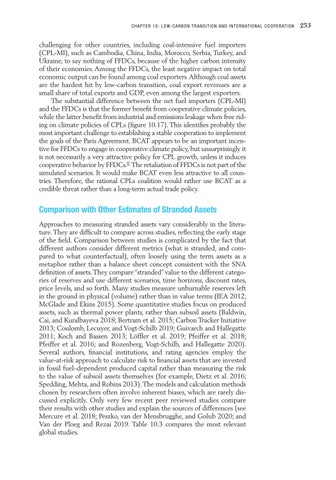CH AP TER 10: LO W-C AR B ON TR ANSITION AND INTER NATIONAL C OOPER ATION
challenging for other countries, including coal-intensive fuel importers (CPL-MI), such as Cambodia, China, India, Morocco, Serbia, Turkey, and Ukraine, to say nothing of FFDCs, because of the higher carbon intensity of their economies. Among the FFDCs, the least negative impact on total economic output can be found among coal exporters. Although coal assets are the hardest hit by low-carbon transition, coal export revenues are a small share of total exports and GDP, even among the largest exporters. The substantial difference between the net fuel importers (CPL-MI) and the FFDCs is that the former benefit from cooperative climate policies, while the latter benefit from industrial and emissions leakage when free riding on climate policies of CPLs (figure 10.17). This identifies probably the most important challenge to establishing a stable cooperation to implement the goals of the Paris Agreement. BCAT appears to be an important incentive for FFDCs to engage in cooperative climate policy, but unsurprisingly it is not necessarily a very attractive policy for CPL growth, unless it induces cooperative behavior by FFDCs.6 The retaliation of FFDCs is not part of the simulated scenarios. It would make BCAT even less attractive to all countries. Therefore, the rational CPLs coalition would rather use BCAT as a credible threat rather than a long-term actual trade policy.
Comparison with Other Estimates of Stranded Assets Approaches to measuring stranded assets vary considerably in the literature. They are difficult to compare across studies, reflecting the early stage of the field. Comparison between studies is complicated by the fact that different authors consider different metrics (what is stranded, and compared to what counterfactual), often loosely using the term assets as a metaphor rather than a balance sheet concept consistent with the SNA definition of assets. They compare “stranded” value to the different categories of reserves and use different scenarios, time horizons, discount rates, price levels, and so forth. Many studies measure unburnable reserves left in the ground in physical (volume) rather than in value terms (IEA 2012; McGlade and Ekins 2015). Some quantitative studies focus on produced assets, such as thermal power plants, rather than subsoil assets (Baldwin, Cai, and Kuralbayeva 2018; Bertram et al. 2015; Carbon Tracker Initiative 2013; Coulomb, Lecuyer, and Vogt-Schilb 2019; Guivarch and Hallegatte 2011; Koch and Bassen 2013; Löffler et al. 2019; Pfeiffer et al. 2018; Pfeiffer et al. 2016; and Rozenberg, Vogt-Schilb, and Hallegatte 2020). Several authors, financial institutions, and rating agencies employ the value-at-risk approach to calculate risk to financial assets that are invested in fossil fuel–dependent produced capital rather than measuring the risk to the value of subsoil assets themselves (for example, Dietz et al. 2016; Spedding, Mehta, and Robins 2013). The models and calculation methods chosen by researchers often involve inherent biases, which are rarely discussed explicitly. Only very few recent peer reviewed studies compare their results with other studies and explain the sources of differences (see Mercure et al. 2018; Peszko, van der Mensbrugghe, and Golub 2020; and Van der Ploeg and Rezai 2019. Table 10.3 compares the most relevant global studies.
253


